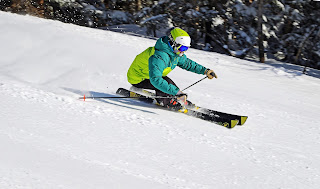Let's talk for a second about how we balance when we ski. Stood still on flat ground it's very easy to balance on skis. But what about when we're sliding down the hill, how can you tell if someone is in balance? Well, purely by the definition of the word, if they're still upright on their skis and not lying in the snow they are in balance! As a result, the PSIA reworded their definition to:
"Control the relationship of the Center of Mass to the base of support to direct pressure along the length of the skis".
This means that we are not just remaining upright on our skis, but controlling how we move our center of mass (COM) in relationship to our feet. For men, the COM is around chest height. For women it's a little lower, and for kids a little higher. Move the COM forward over the toes and we pressure the tips of the skis, backwards and we pressure the tails. As good instructors we know that skiing in the back seat is bad, so although you may see a student balanced on their skis, it may not be ideal for ski performance.
Like I said, you can't balance for your students but you can create sensations that allow them to feel what "good" balance feels like, and hence what "good" ski performance feels like. The most common thing you'll see is students skiing in the back seat and/or stiff legged. The lower leg is at 90* to the ski and their hips back behind their feet. As a result, their turns lack shape and they probably struggle to control speed on steeper terrain because they can't steer the legs from this position. The physics of ski performance and the anatomy of the human body dictates that it's not possible... try it!!
So how can we create sensations that promote "good" balance? Activities I've used include shuffling, hopping, 1000 steps, thumper turns, outside ski to outside ski & skiing on one ski. In order for a student to complete any of these tasks they must actively move their COM forward over their feet. If they don't, they won't be able to complete the task. When the COM is directly over the base of support, rotary movements can happen a lot easier. For performance skiing, have your students move their COM further forward over their toes.


No comments:
Post a Comment